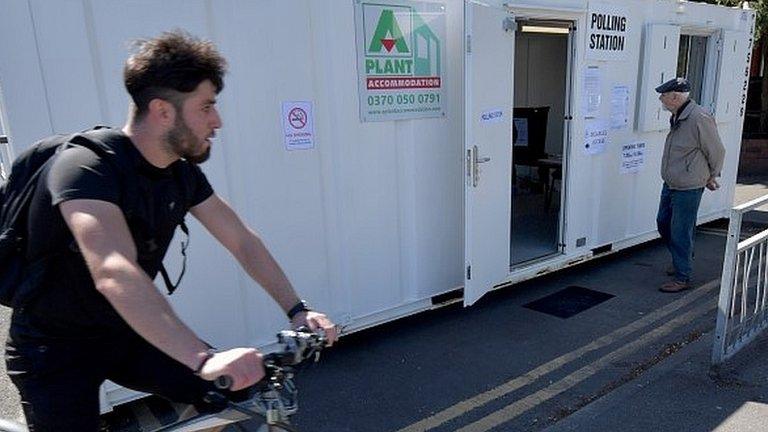The election debate we're not having
- Published

The setting: our local burgh hall. The event: six out of eight candidates at a hustings for our four-member council ward.
Over 90 minutes, this was less of a contact sport or debate than a job interview. Some were a lot better prepared than others.
We talked about rogue landlords, officialdom's (allegedly) deaf ear to community planning, boy racers and recycling bins. No-one even mentions either Brexit or independence.
Nor is there much discussion of the issue what will surely dominate councillors' time for the next term of office - the squeeze on their budgets.
Yes, we've heard it's coming. We've heard blame apportioned for the political decisions behind it; austerity budgeting from Westminster, or council tax freezes from Holyrood, or inefficiency in councils.

We've heard conflicting claims of what is happening to the total budget this year: 'slashed,' says one side: 'boosted', says the other.
Both are right. Budgets are going up, but with the help of higher council tax bills, at least for some. And more central government grant comes with significant extra responsibility for social care provision.
Yet beyond the electoral air war about the constitution, at ground level, what are your candidates going to do to handle the looming squeeze, other than complain about it? How will they prioritise? If you know, you're in a small minority.
Scale of the squeeze
Here's some background that might help. It's drawn from analysis by Audit Scotland and the Fraser of Allander Institute at Strathclyde University.
Between 2010-11, when the current squeeze began, and the current financial year, the cash flowing to local government to run services has barely changed. In real terms - real spending power - that money buys around 9.5% less.
If you take out the £120m in the Attainment Fund for disadvantaged pupils, which is going directly to head teachers, that fall is close to 10.6%.
With net spend of more than £10 billion, it is reckoned that the total budget is down by around £1 billion in real terms.
While health has been protected, local government revenue, or day-to-day, spending, has been squeezed as a share of the Scottish government budget.
The Allander economists reckon that maintaining its share would have delivered £570m more by now. But it's proven hard to argue with the political priority of ring-fencing the NHS.

So raising council tax can fill that gap, right? Wrong. In its ninth year of freeze, council tax last year raised 11% of councils' total budgets. That is going up this year, because £110m should be raised from lifting budgets on more expensive bands of house valuation.
But a council that also raises its council tax across all bands by the maximum level allowed, 3%, will deliver an increase to the total budget of around 0.3%. It draws political heat, without much financial advantage.
This is an important but often overlooked issue. Councils used to get half their income from local rates. That share was sharply cut through the introduction of the poll tax, then council tax, then a council tax freeze.
The decisions made on rate-setting used to have a big impact on householders and on services. At less than 15% of council budgets raised from council tax, there's far less link between the electorate's choices and the decisions made on tax and spending.
Spending priorities
Through the squeeze years, the total budget for council social work has grown. As a share of total council spend, it is up from 27% to 30%. But other spending categories have fallen.
Within education, only pre-primary has seen growth, to meet Scottish government targets for nursery provision. Community learning spend is down more than 25%.
That social work growth is linked to 10% more being spent on children and families. Demographic change is putting pressure on services. The gross social spend by councils on "older persons" has fallen 2% since 2010-11, but when the contributions from service users are included, the spend is up around 3%.
Categories that have fallen fastest include economic development and planning, down 21%. That could be related to Scotland's growth slowdown in the past two years.
Roads and transport is down by a similar amount, though it is offset to a modest extent by higher revenue from parking charges.
'Culture and related' budgets are down by an eighth, including library spending down 13% and parks by 20%. Sports day-to-day spend, after accounting for increased user fees at the swimming pool etc, is down 12%.
Councillors have seen their own costs squeezed more than most. 'Corporate and democratic services' are down 23% since 2010.
Fair distribution?
How evenly is funding distributed? Total estimated expenditure per person is just above £2,000. That varies. In Edinburgh and Aberdeen, it's close to £1600. In the Western Isles, it's nearly double the average.
But does that mean it goes where it has the biggest impact, or where it is most needed? Not really.
The Fraser of Allander analysis follows the new Attainment Fund spend as a guide to where pupils are most in need of support. It shows Glasgow gets 180% of the average spend per head for the Attainment Fund, but the city gets 107% of mainstream spending per pupil.

The funding formula is differs in some respects for predominantly rural local authorities
The island authorities get at least 125% of mainstream spend per head, but qualify for less than half the Attainment Fund per pupil.
There are good reasons for that. It is more expensive to provide schooling to a national standard in small, rural and island schools.
But from the Strathclyde University economists comes a challenge: the Scottish government has been talking about the importance of achieving the best outcomes with public funds, but its allocations are instead still dominated by inputs - including the number of teachers.
It observes that the Welsh government looked at ways to make the shift from measuring education by the amount spent to allocation of money where it gets the best outcomes. The idea was dropped when ministers saw how difficult it looked.
The outlook
The allocations to local councils have not been made for next financial year or beyond. Public finance experts complain that is no help to effective planning of services or staff, and urge multi-year planning.
But you can make some assumptions of what should be expected, on the basis of forecasts from the Office for Budget Responsibility, and which services are being protected by Scottish ministers (the NHS and the police) or expanded (childcare).
Unless there is significant additional use of Holyrood's new tax powers, that gives a real terms cut for unprotected services of more than 9% over the next three years.
"Given that local government revenue funding accounts for just over half of the Scottish government's unprotected portfolio spending, some degree of real terms cut seems inevitable," according to the Fraser of Allander report.
And if, say, schools are better protected than others, then the others will suffer all the more.
The pressures
The outlook is not all about spending choices. It is also about the changing demands on council services, over which they have little or no choice.
The obvious one is demographic. Over the five-year course of this Holyrood parliament, the number of people aged 65 and above is going up by 7%. Between 2016 and 2025, it is on track to rise by 19%.
By 2039 (as far away from now as 1995), the number of Scots aged 75 and above is forecast to rise by 85%, to more than 800,000. I'll be joining them that year, if I make it that far - a tail ender in the post-war baby boom.
For many, of course these can be the golden years. But for many others, they bring high care costs.

Long before then - right now, in fact - there's inflation, fuelling pressure for public sector pay to break through its recurring 1% annual constraint.
That's after many lower-paid council workers already got a lift up to the Living Wage level, and auto-enrolment into pensions - all eating into council budgets.
Renfrewshire Council has calculated its costs from that single pension requirement. Extrapolated across Scotland by Audit Scotland, it comes to £90m a year.
Other national reforms are placing new requirements on councils; more childcare, merger of health and social care budgets, community justice, the educational attainment gap, the training levy. European funding is being removed, business rates are being reviewed, and the system of council tax remains unsettled.
Brexit may also choke off recruitment from the rest of the European Union, making it more difficult and expensive to find sufficient social care staff.
Careful where you cut
The Accounts Commission watchdog of councils, reflecting on the Audit Scotland analysis, politely concludes that councillors elected this week will have to raise their game in medium-term and strategic financial planning.
That will involve careful application of redundancy policies, to ensure that they retain the skilled staff needed to keep services functioning.
Between 2011 and last year, the number of (full-time equivalent) staff fell 7%, or 15,000, to 198,000. That decline can be expected to continue. Yet only half of councils were found by their watchdog to have workforce plans.
Those freshly-minted councillors are also invited to ask why outcomes from services are not that closely linked to funds available. In other words, the same funding in comparable areas is producing markedly different results. In some cases, less funding has been accompanied by improved performance.
And it is gently suggested by the Accounts Commission that councillors need to enhance their skills in handling this budget squeeze. There are difficult choices about how to reform services, both to run them and to hold them accountable in councillors' "complex and evolving roles".
- Published30 April 2017

- Published3 May 2017
